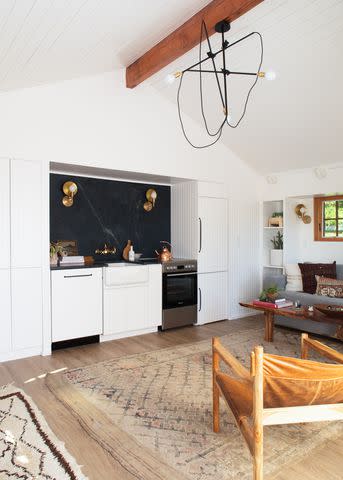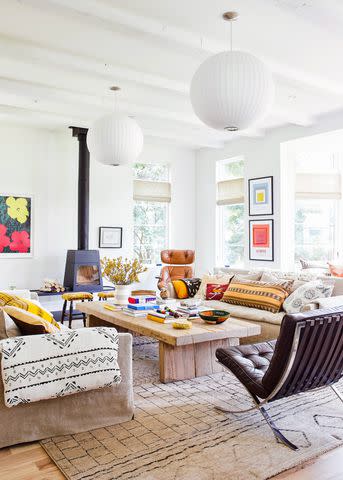Rethinking Your Open Concept? Designer Tricks for Creating Defined Spaces
Get tips for mixing colors and patterns, lighting ideas, sofa placement, and more.

An open floor plan can seem like a good idea—until it’s time to furnish it, select paint colors, and generally figure out how to live in your new wide-open spaces. You might wish for a return to walls once you embark on the process, but calling to mind the reason you opted for this layout in the first place is a good place to start strategizing your design. “Open floor plans have been the reigning layout of choice for the past decade, particularly in new builds, and there’s a good reason for it,” says Heather Goerzen, Havenly design editor. “Not only do they manifest that quintessential light, bright, and airy feel, but they also encourage easy gatherings and general togetherness.”
The trick to designing an open-concept layout isn’t necessarily putting up makeshift walls in the form of furnishings but creating individual moments for specific areas while maximizing flow. “The goal is a space that seamlessly transitions from living, dining, cooking, and playing, with distinct parameters,” Goerzen says. “Without dividing walls and hallways, you should consider how to best arrange furniture and decor to create division and walkways, such that there are clearly delineated spaces.”
Layering, thoughtful placement of furniture, and utilizing tucked-away corners for work or retreat will help give your home’s layout purpose while creating an environment that’s both cozy and warm, says Goerzen. Here, she shares tips for designing an open-concept living area with distinct spaces.

1. Make It Functional
Considering how you live in your space is the first step in any design process—whether for an open floor plan or not. “More than likely, you’re going to have areas that pull double-duty (eating and working, resting and exercising),” says Goerzen. “Knowing what activities you’d like to address will help you maximize your space through thoughtful design elements.” Storage, in particular, is key. If you plan to use a corner as a reading nook, try adding a bookcase. The same concept applies if you’re carving out a workout area, where Goerzen suggests using a basket to corral equipment like weights and mats.
2. Use Color
When it comes to color selection in an open-concept living area, things can get tricky. Goerzen says the key is to stick to an overarching style and palette for the entire space. “While you want it to feel layered, interesting, and uniquely you, maintaining a design POV will help ensure it doesn’t fall into the ‘chaos’ territory,” she says.
That said, you can highlight certain colors within the palette for impact. “For example, [opt for] a statement olive-green sofa in your living space or trending blue hues on your kitchen cabinets, but make sure to carry (and vary) these general tones throughout the space to create a sense of balance,” she explains. “Let’s avoid theming your open area by color.”
Goerzen adds that the statement wall is a no-no in open layouts. Instead, go for an inclusive look. And rather than relying on a bucket of paint to do the job, she suggests calling on wallpaper, French molding, or wainscotting to provide interest and maximize impact.
:
3. Mix Styles
Your personal style should be apparent throughout every space, without necessarily sticking to one aesthetic or genre. In fact, Goerzen recommends purposefully layering aesthetics. “The days of only farmhouse or only midcentury are long gone,” she says. “So go ahead and mix and match: juxtaposing vintage elements with more modern counterparts, organic materials with luxurious accents, or whatever your design heart loves.” The one rule to keep in mind? Take this layering approach throughout your entire open area in order to avoid themed sections. When executed properly, layering can bring about a warm, inviting atmosphere with interest and appeal.

4. Rely on Rugs
Set the parameters from the floor up. Rugs are a subtle way to create definition within an open area—just make sure they work nicely with each other by creating a harmonious contrast with pattern, shape, texture, and color. One way Goerzen recommends keeping things fresh is by throwing in a wild card. “A hide can always be an interesting rug to mix into a smaller seating nook to introduce an asymmetrical element,” she says.
:
5. Light It Up
Emphasizing lighting and how it plays into each space is imperative. Not only can it create definition, but it’s also a big factor when it comes to ambiance. “You can feature a statement chandelier over the dining table, alongside sconces flanking your living room mantel, and a separate pendant in the entryway (and lamps and more!),” says Goerzen. As with all aspects of open-concept design, lighting elements should work well together but also create their very own moment.

6. Float Furniture
“A common design mistake we see often is placing all of the furniture along the walls, leaving the center of the room bare and empty,” says Goerzen. “While it might seem counterintuitive, floating some of the furniture off the walls (particularly pieces like sofas and accent chairs) will actually give the illusion of a larger, more layered space.” With this method, you can still create boundaries within an open room. Goerzen gives examples such as the back of a sofa or a low bookcase acting to separate a living area from a dining area. The trick is to get comfortable giving your walls some breathing room. You’ll find it pays off in both the function and feel of your space.
7. Go with the Flow
Goerzen says not every area needs a focal point. For her, the biggest objective is to have a space that hits its stride on both flow and function. “Perhaps there is a feature like a fireplace or window that clearly defines an area, but there might also be a long stretch of wall that’s just intuitive for your dining table to go,” she says. Even paying attention to maximizing underutilized spaces by placing a chair or desk in a small corner nook can instantly upgrade your space’s functionality.

